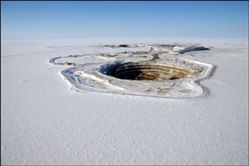
Kimberlites’ rapid rise may be fuelled by exsolving carbon dioxide gas, if the parent magma is carbonatitic, say Canadian researchers. Monique Tsang reports.
Geoscientist Online 12 March 2012
The trip is long and rough, but as many diamond die-hards would agree, well worth it. Kimberlite, an igneous rock in which diamonds occur, hails from deep underground. Kimberlite magmas travel up through about 150km of continental lithosphere, picking up plenty of mineral cargo along the way – sometimes including diamonds.
Image: Kimberlite mines hold the record for the world's deepest man-made holes in the ground
Geologists have known for a long time that kimberlite magma rises up the mantle more quickly than any other kind of magma, at speeds five to ten times faster than average. Some have thought that this rapid rise could be due to the 'exsolution' of dissolved volatile substances such as carbon dioxide (CO2) and water in the magma, meaning that the substances are no longer being held in their dissolved state. This could cause pockets of liquid carbon dioxide and water to form in the magma, making it more buoyant and rise faster. But exactly how this worked remained unclear – until now.
Kelly Russell and Lucy Porritt, from University of British Columbia, Canada, have found that carbon dioxide dissolved in the rising magma could easily be coaxed into exsolving to a CO2-rich fluid phase if the magma starts its journey as a 'carbonatitic' melt.
Carbonatitic melts are rich in CO2 but low in silica, so providing plenty of CO2 to react with the mineral cargo picked up by the magma 'elevator' as it rises. Among the cargo is orthopyroxene, a regular mantle mineral. As orthopyroxene is rich in silica, it is the most reactive mantle mineral when brought into contact with silica-poor carbonatitic melt.
“As soon as the carbonatitic melt comes into the mantle lithosphere, the orthopyroxene dissolves, and we were able to show the dissolution rates are very fast,” Russell tells Geoscientist Online.
Russell and Porritt, with their colleagues from the Ludwig Maximilian University of Munich, Germany, ran high-temperature 'analogue' experiments in the laboratory to show the concept of this chemical reaction, as seen in the effervescence of the reaction ingredients.
As orthopyroxene dissolves, the melt becomes enriched with silica. CO2 is less soluble in a more silica-rich melt, so the melt has no choice but to exsolve the excess CO2 as a fluid phase. “This forces the production of the fluid phase which cuts the density” Russell adds.
The pair calculated that dissolving an amount of orthopyroxene equivalent to 15% of the weight of the melt could create enough exsolved fluid to reduce the density of the melt by some 20%.
Although the new cargo adds weight to the load, the newly formed liquid CO2 reduces the overall density of the melt so much that it effectively contains pockets of 'hot liquid balloon' to turbocharge the melt in its ascent. And as the melt rises it experiences less pressure. This makes the magma even less dense, further increasing its buoyancy.
The research is important because it can help geologists recover the history of ancient volcanic activity. Russell and colleagues plan to run the same experiments on olivine. They hope that by comparing the time required to dissolve olivine, and the amount of CO2 produced, against their results for orthopyroxene, they can better constrain the kimberlite magma's speed of ascent.
Reference
- “Kimberlite ascent by assimilation-fuelled buoyancy”, Nature (2012; doi:10.1038/nature10740). Kelly Russell, Lucy A. Porritt, Yan Lavallée, and Donald B. Dingwell.